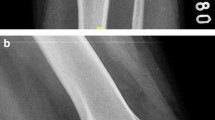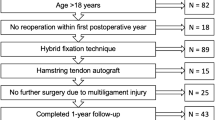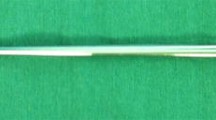Abstract
Purpose
The purpose of this study was to investigate the incidence of cyclops lesions and its relationship with the cross-sectional area of the intercondylar notch.
Methods
For this study, 55 patients (24 male and 31 female) underwent follow-up arthroscopy after bi-socket anterior cruciate ligament reconstruction with hamstring tendon grafts were included. All patients underwent magnetic resonance imaging measurements of intercondylar notch dimensions. We compared the femoral intercondylar notch sizes and bone tunnel sizes between knees with cyclops lesions (cyclops group) and those without cyclops lesions (no-cyclops group). The mean percentage of the tunnel size to the cross-sectional area of the femoral intercondylar notch was also compared between the groups. The median follow-up duration was 3.8 years.
Results
Cyclops lesions were found in 15 of the 55 knees (27.3 %) on second-look arthroscopy (cyclops group). Only 6 of the 55 knees (10.9 %) had extension loss (cyclops syndrome). The cyclops group included 3 men and 12 women. The two groups showed a statistical difference in sex variation (P = 0.04). No significant differences were found in the femoral and tibial tunnel sizes between the two groups. The cross-sectional area of the femoral intercondylar notch was significantly smaller in the cyclops group (251.7 ± 63.2 mm2) than in the no-cyclops group (335.6 ± 77.6 mm2) (P < 0.001). The percentage of the total femoral tunnel size to the cross-sectional area of the femoral intercondylar notch was significantly higher in the cyclops group (18.6 ± 5.3 %) than in the no-cyclops group (13.2 ± 3.6 %) (P = 0.02).
Conclusions
A smaller intercondylar notch size may be a potential risk factor for cyclops lesion formation.
Level of evidence
Case–control study, Level IV.



Similar content being viewed by others
References
Ahn JH, Yoo JC, Yang HS et al (2007) Second-look arthroscopic findings of 208 patients after ACL reconstruction. Knee Surg Sports Traumatol Arthrosc 15(3):242–248
Anderson AF, Dome DC, Gautam S et al (2001) Correlation of anthropometric measurements, strength, anterior cruciate ligament size, and intercondylar notch characteristics to sex differences in anterior cruciate ligament tear rates. Am J Sports Med 29(1):58–66
Araki D, Kuroda R, Kubo S et al (2011) A prospective randomised study of anatomical single-bundle versus double-bundle anterior cruciate ligament reconstruction: quantitative evaluation using an electromagnetic measurement system. Int Orthop 35(3):439–446
Baker SJ, Gill GW, Kieffer DA (1995) Race and sex determination from the intercondylar notch of the distal femur. In: Gill GW, Rhine S (eds) Skeletal attribution of race. Churchill Livingstone, New York, pp 91–95
Bernard M, Hertel P, Hornung H et al (1997) Femoral insertion of the ACL. Radiographic quadrant method. Am J Knee Surg 10:14–22
Bradley DM, Bergman AG, Dillingham MF (2000) MR imaging of cyclops lesions. Am J Roentgenol 174(3):719–726
Cha J, Choi SH, Kwon JW et al (2012) Analysis of cyclops lesions after different anterior cruciate ligament reconstructions: a comparison of the single-bundle and remnant bundle preservation techniques. Skeletal Radiol 41(8):997–1002
Charlton WP, St John TA, Ciccotti MG et al (2002) Differences in femoral notch anatomy between men and women: a magnetic resonance imaging study. Am J Sports Med 30(3):329–333
Dandy DJ, Edwards DJ (1994) Problems in regaining full extension of the knee after anterior cruciate ligament reconstruction: does arthrofibrosis exist? Knee Surg Sports Traumatol Arthrosc 2:76–79
Delcogliano A, Franzese S, Branca A et al (1996) Light and scan electron microscopic analysis of Cyclops syndrome: etiopathogenic hypothesis and technical solutions. Knee Surg Sports Traumatol Arthrosc 4:194–199
Delincé P, Krallis P, Descamps PY et al (1998) Different aspects of the cyclops lesion following anterior cruciate ligament reconstruction: a multifactorial etiopathogenesis. Arthroscopy 14(8):869–876
Dienst M, Schneider G, Altmeyer K et al (2007) Correlation of intercondylar notch cross sections to the ACL size: a high resolution MR tomographic in vivo analysis. Arch Orthop Trauma Surg 127(4):253–260
Domzalski M, Grzelak P, Gabos P (2010) Risk factors for anterior cruciate ligament injury in skeletally immature patients: analysis of intercondylar notch width using magnetic resonance imaging. Int Orthop 34:703–707
Fung DT, Hendrix RW, Koh JL et al (2007) ACL impingement prediction based on MRI scans of individual knees. Clin Orthop Relat Res 460:210–218
Gohil S, Falconer TM, Breidahl W (2013) Serial MRI and clinical assessment of cyclops lesions. Knee Surg Sports Traumatol Arthrosc. doi:10.1007/s00167-013-2480-5
Hamada M, Shino K, Horibe S et al (2001) Single- versus bi-socket anterior cruciate ligament reconstruction using autogenous multiple-stranded hamstring tendons with endo button femoral fixation: a prospective study. Arthroscopy 17(8):801–807
Hamada M, Shino K, Horibe S et al (2005) Changes in cross-sectional area of hamstring anterior cruciate ligament grafts as a function of time following transplantation. Arthroscopy 21:917–922
Iriuchishima T, Ryu K, Yorifuji H et al (2013) Commonly used ACL autograft areas do not correlate with the size of the ACL footprint or the femoral condyle. Knee Surg Sports Traumatol Arthrosc. doi:10.1007/s00167-013-2595-8
Jackson DW, Schaefer RK (1990) Cyclops syndrome: loss of extension following intra-articular anterior cruciate ligament reconstruction. Arthroscopy 6:171–178
Kawakami Y, Hiranaka T, Matsumoto T et al (2012) The accuracy of bone tunnel position using fluoroscopic-based navigation system in anterior cruciate ligament reconstruction. Knee Surg Sports Traumatol Arthrosc 20:1503–1510
Kondo E, Yasuda K, Azuma H et al (2008) Prospective clinical comparisons of anatomic double-bundle versus single-bundle anterior cruciate ligament reconstruction procedures in 328 consecutive patients. Am J Sports Med 36(9):1675–1687
Kropf EJ, Shen W, van Eck CF et al (2013) ACL–PCL and intercondylar notch impingement: magnetic resonance imaging of native and double-bundle ACL-reconstructed knees. Knee Surg Sports Traumatol Arthrosc 21:720–725
LaPrade RF, Burnett QM II (1994) Femoral intercondylar notch stenosis and correlation to anterior cruciate ligament injuries. A prospective study. Am J Sports Med 22:198–203
Marzo JM, Bowen MK, Warren RF et al (1992) Intraarticular fibrous nodule as a cause of loss of extension following anterior cruciate ligament reconstruction. Arthroscopy 8:10–18
Muellner T, Kdolsky R, Groschmidt K et al (1999) Cyclops and cyclopoid formation after anterior cruciate ligament reconstruction: clinical and histomorphological differences. Knee Surg Sports Traumatol Arthrosc 7:284–289
Muneta T, Takakuda K, Yamamoto H (1997) Intercondylar notch width and its relation to the configuration and cross-sectional area of the anterior cruciate ligament. A cadaveric knee study. Am J Sports Med 25(1):69–72
Rosenberg TD, Graf B (1994) Techniques for ACL reconstruction with multi-trac drill guide. Acufex Microsurgical, Mansfield
Shelbourne KD, Davis TJ, Klootwyk TE et al (1998) The relationship between intercondylar notch width of the femur and the incidence of anterior cruciate ligament tears. A prospective study. Am J Sports Med 26:402–408
Siebold R, Dehler C, Ellert T (2008) Prospective randomized comparison of double-bundle versus single-bundle anterior cruciate ligament reconstruction. Arthroscopy 24:137–145
Simon RA, Everhart JS, Nagaraja HN et al (2010) A case-control study of anterior cruciate ligament volume, tibial plateau slopes and intercondylar notch dimensions in ACL-injured knees. J Biomech 43(9):1702–1707
Sonnery-Cottet B, Lavoie F, Ogassawara R et al (2010) Clinical and operative characteristics of cyclops syndrome after double-bundle anterior cruciate ligament reconstruction. Arthroscopy 26:1483–1488
Souryal TO, Freeman TR (1993) Intercondylar notch size and anterior cruciate ligament injuries in athletes. A prospective study. Am J Sports Med 21:535–539
Souryal TO, Moore HA, Evans JP (1988) Bilaterality in anterior cruciate ligament injuries: associated intercondylar notch stenosis. Am J Sports Med 16(5):449–454
Taketomi S, Nakagawa T, Takeda H et al (2011) Anatomical placement of double femoral tunnels in anterior cruciate ligament reconstruction: anteromedial tunnel first or posterolateral tunnel first? Knee Surg Sports Traumatol Arthrosc 19:424–431
Tonin M, Saciri V, Veselko M et al (2001) Progressive loss of knee extension after injury. Cyclops syndrome due to a lesion of anterior cruciate ligament. Am J Sports Med 29:545–549
Tsukada H, Ishibashi Y, Tsuda E et al (2008) Anatomical analysis of the anterior cruciate ligament femoral and tibial footprints. J Orthop Sci 13:122–129
Uhorchak JM, Scoville CR, Williams GN et al (2003) Risk factors associated with noncontact injury of the anterior cruciate ligament: a prospective four-year evaluation of 859 West Point cadets. Am J Sports Med 31:831–842
Vaidya SV, Ranawat CS, Aroojis A et al (2000) Anthropometric measurements to design total knee prostheses for the Indian population. J Arthroplasty 15(1):79–85
Van Dijck RA, Saris DB, Willems JW et al (2008) Additional surgery after anterior cruciate ligament reconstruction: can we improve technical aspects of the initial procedure? Arthroscopy 24(1):88–95
Van Eck CF, Martins CA, Lorenz SG et al (2010) Assessment of correlation between knee notch width index and the three-dimensional notch volume. Knee Surg Sports Traumatol Arthrosc 18(9):1239–1244
Wang J, Ao Y (2009) Analysis of different kinds of cyclops lesions with or without extension loss. Arthroscopy 25:626–631
Yasuda K, Kondo E, Ichiyama H et al (2006) Clinical evaluation of anatomic double-bundle anterior cruciate ligament reconstruction procedure using hamstring tendon grafts: comparisons among 3 different procedures. Arthroscopy 22:240–251
Zeng C, Gao SG, Wei J et al (2013) The influence of the intercondylar notch dimensions on injury of the anterior cruciate ligament: a meta-analysis. Knee Surg Sports Traumatol Arthrosc 21(4):804–815
Acknowledgments
We thank Ms. Aki Yoshida, Ms. Reina Tanaka, and Ms. Emi Matsumoto for their technical cooperation. This work was supported by the grant from Japan Society for the Promotion of Science (No. 24791546, T.F.).
Author information
Authors and Affiliations
Corresponding author
Rights and permissions
About this article
Cite this article
Fujii, M., Furumatsu, T., Miyazawa, S. et al. Intercondylar notch size influences cyclops formation after anterior cruciate ligament reconstruction. Knee Surg Sports Traumatol Arthrosc 23, 1092–1099 (2015). https://doi.org/10.1007/s00167-014-2891-y
Received:
Accepted:
Published:
Issue Date:
DOI: https://doi.org/10.1007/s00167-014-2891-y




